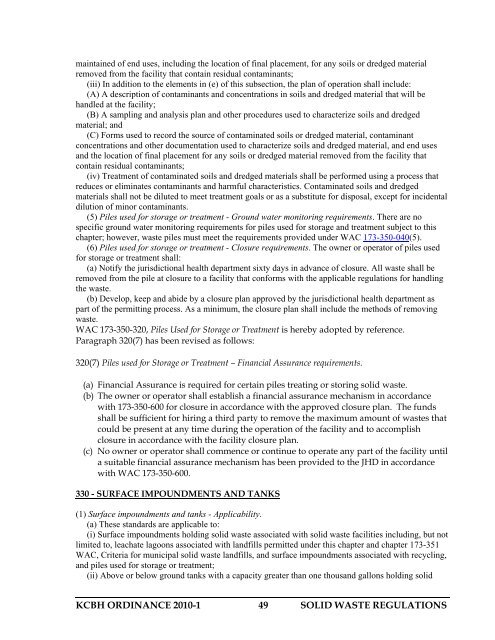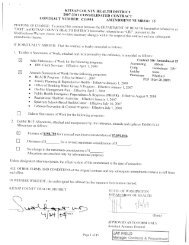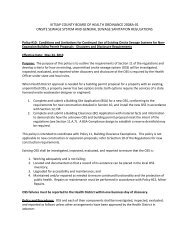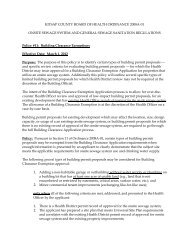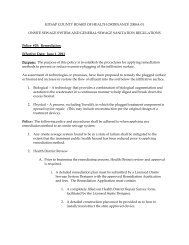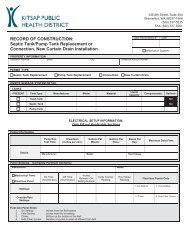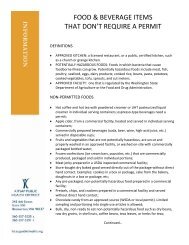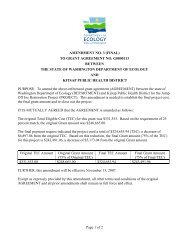SOLID WASTE REGULATIONS - Kitsap Public Health District
SOLID WASTE REGULATIONS - Kitsap Public Health District
SOLID WASTE REGULATIONS - Kitsap Public Health District
Create successful ePaper yourself
Turn your PDF publications into a flip-book with our unique Google optimized e-Paper software.
maintained of end uses, including the location of final placement, for any soils or dredged material<br />
removed from the facility that contain residual contaminants;<br />
(iii) In addition to the elements in (e) of this subsection, the plan of operation shall include:<br />
(A) A description of contaminants and concentrations in soils and dredged material that will be<br />
handled at the facility;<br />
(B) A sampling and analysis plan and other procedures used to characterize soils and dredged<br />
material; and<br />
(C) Forms used to record the source of contaminated soils or dredged material, contaminant<br />
concentrations and other documentation used to characterize soils and dredged material, and end uses<br />
and the location of final placement for any soils or dredged material removed from the facility that<br />
contain residual contaminants;<br />
(iv) Treatment of contaminated soils and dredged materials shall be performed using a process that<br />
reduces or eliminates contaminants and harmful characteristics. Contaminated soils and dredged<br />
materials shall not be diluted to meet treatment goals or as a substitute for disposal, except for incidental<br />
dilution of minor contaminants.<br />
(5) Piles used for storage or treatment - Ground water monitoring requirements. There are no<br />
specific ground water monitoring requirements for piles used for storage and treatment subject to this<br />
chapter; however, waste piles must meet the requirements provided under WAC 173-350-040(5).<br />
(6) Piles used for storage or treatment - Closure requirements. The owner or operator of piles used<br />
for storage or treatment shall:<br />
(a) Notify the jurisdictional health department sixty days in advance of closure. All waste shall be<br />
removed from the pile at closure to a facility that conforms with the applicable regulations for handling<br />
the waste.<br />
(b) Develop, keep and abide by a closure plan approved by the jurisdictional health department as<br />
part of the permitting process. As a minimum, the closure plan shall include the methods of removing<br />
waste.<br />
WAC 173-350-320, Piles Used for Storage or Treatment is hereby adopted by reference.<br />
Paragraph 320(7) has been revised as follows:<br />
320(7) Piles used for Storage or Treatment – Financial Assurance requirements.<br />
(a) Financial Assurance is required for certain piles treating or storing solid waste.<br />
(b) The owner or operator shall establish a financial assurance mechanism in accordance<br />
with 173-350-600 for closure in accordance with the approved closure plan. The funds<br />
shall be sufficient for hiring a third party to remove the maximum amount of wastes that<br />
could be present at any time during the operation of the facility and to accomplish<br />
closure in accordance with the facility closure plan.<br />
(c) No owner or operator shall commence or continue to operate any part of the facility until<br />
a suitable financial assurance mechanism has been provided to the JHD in accordance<br />
with WAC 173-350-600.<br />
330 - SURFACE IMPOUNDMENTS AND TANKS<br />
(1) Surface impoundments and tanks - Applicability.<br />
(a) These standards are applicable to:<br />
(i) Surface impoundments holding solid waste associated with solid waste facilities including, but not<br />
limited to, leachate lagoons associated with landfills permitted under this chapter and chapter 173-351<br />
WAC, Criteria for municipal solid waste landfills, and surface impoundments associated with recycling,<br />
and piles used for storage or treatment;<br />
(ii) Above or below ground tanks with a capacity greater than one thousand gallons holding solid<br />
KCBH ORDINANCE 2010-1 49 <strong>SOLID</strong> <strong>WASTE</strong> <strong>REGULATIONS</strong>


